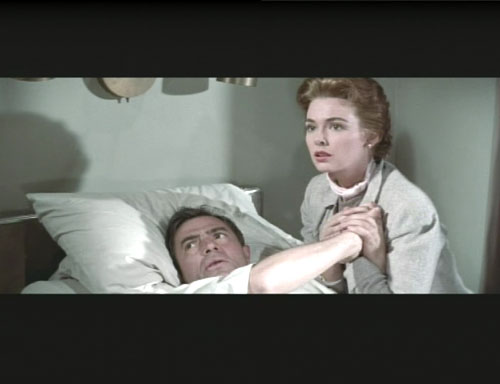
Bigger than Life plays as part of a 15-film series at New York’s Film Forum on July 24th & 25th.
***
In a Lonely Place and Bigger than Life (1956) are the only two movies in Nicholas Ray’s body of work that qualify as horror films. Bigger than Life, however, offers none of Lonely Place’s possibilities of hope. The terror of the soul—expressed both individually and societally—is exposed to such a suffocating and unbearable degree that one may actually want to accept the “happy” ending that finds schoolteacher Ed Avery (James Mason) in the arms of his doting family. As usual, Ray uses the skeleton of a genre—in this case, the family melodrama—to plumb something which infests its underbelly. Like In a Lonely Place, freedom for the hero comes at a terrible cost.
Ed and his wife Lou’s (Barbara Rush) story is as far from the rapturous dreams of Ray’s other couples as one can imagine. They cannot live for each other in another world outside of the real because the real is what has exploded to the surface of Ed’s psyche. This is, as many have previously stated, a nightmare.
Ray’s dreams exist in suspended time; his nightmares are smothered by cavernous space. Ray’s genius is to evoke the inner states of his characters through the spaces they inhabit. And rarely has a suburban household been so physically claustrophobic. Ray sets his characters deep into space, and frequently places them together, in amazing tension. One can feel the walls as they close in around the madman and his family. Although Ed’s desires for a grander existence are explicitly stated, Ray makes the house itself an implicit agent of oppression by placing artwork of the world in the background, a dream constantly within reach, but only as an image.


Even when Ed attempts to dominate the space around him, he is overshadowed by the institutions he wants to tear down. Jonathan Rosenbaum points to the moment where Ed tells his wife he feels “ten feet tall,” followed by a grotesque low-angle shot that finishes by diminishing Ed against the school building. Similarly, whenever Ed is in the house, he tries to use his body to supplant Lou and their son Richie (Christopher Olsen), but the house still takes him over.




Once the cortisone kicks in, Ed certainly begins to speak truth to power. He laughs at modern education, at the nuclear family, at organized religion, and so many other tentpoles of 1950s prosperity and stability. But the fact that it takes a madman to bring these views to light is what is truly frightening. Ray complicates matters even further by making Lou a reservoir of quiet sadness. Rush gives Lou a powerful whisper, a subdued but emotionally distraught, constant presence. She is emblematic of the world that Ed rejects, but her tenderness and loyalty give a human face to the abstract forces Ed reviles.



Many of Ray’s deep-focus shots also integrate his radical use of sound, something rarely discussed in the filmmaker’s work. Sound relates to space in ways that make the cavernous quality of the house even more palpable. People’s voices echo. Ed’s collapse in front of the house makes the doorbell buzz for what feels like hours. In the climactic fight between Ed and his best friend Wally (Walter Matthau), the carnival music from the television set drowns everything else out. The symbols of the normal life are ever-present, taking Ed, Lou and Richie over.



And what of the ending? “I’ve been so far away from you, come closer, closer, closer!” Ed wakes up from his nightmare only to smother himself in the trap which has existed from the beginning. The sterility of the hospital room, the shadow of the lamp hanging over them, Ed’s lunatic smile; The Averys have awoken from one nightmare only to return to the repressed state in which we first found them.

***
Homes for Strangers: The Cinema of Nicholas Ray is an on-going series of articles covering the 2009 retrospective on Nicholas Ray, running from July 17th to August 6th—with a special bonus on August 16th & 17th at the Anthology Film Archives—at New York's Film Forum.